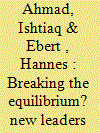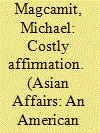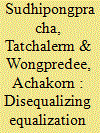| Srl | Item |
| 1 |
ID:
138497


|
|
|
|
|
| Summary/Abstract |
The election of new governments in Pakistan and India in 2013 and 2014, respectively, has sparked controversies about the likely trajectory of the enduring rivalry. Emerging individual and domestic conditions reportedly created new opportunities for incremental rapprochement. Equipped with strong political mandates and backed by powerful constituencies, Pakistan's Nawaz Sharif and India's Narendra Modi initially set out to stabilize and revive their countries’ fragile economies and declared improved bilateral ties as a key precondition for implementing their economic agendas. However, mutual recriminations and border tensions resurfaced soon to prevent the revival of the stalled diplomatic dialogue in late 2014. Drawing on a thorough review of research on rivalry maintenance and termination and, in particular, the assumptions of the punctuated equilibrium model developed by Paul Diehl and Gary Goertz, this paper demonstrates how the conflict's structural complexities are likely to persist and undermine the chances for conflict resolution in the years ahead. The prevalent role of the army and a vibrant anti-Indian Islamic ideology in Pakistan, the persistence of a conflict lobby in India, lingering territorial feuds and ever increasing power asymmetries between the two countries, and decreasing third-party mediation in the Indo-Pakistani conflict will likely suffocate any initiative, however well-intended or pragmatic it may be. Even if bold leadership manages to revive a comprehensive peace process, it would have to be based on systematic confidence building measures in order to make it resilient to crises.
|
|
|
|
|
|
|
|
|
|
|
|
|
|
|
|
| 2 |
ID:
138496


|
|
|
|
|
| Summary/Abstract |
The Barisan Nasional's construction and implementation of ideational and material security apparatuses has created a one-sided internal security dilemma in Malaysia. This paper argues that the noble objective of promoting Malay interests has been transformed to the venal objective of securing Barisan's political perpetuity that is being pursued under the pretext of achieving inter-ethnic parity within a pluralistic Malaysia. The government's quest for a bumiputra-imagined nation gave birth to affirmative action policies that have often worked at the expense of all other Malaysian ethnic groups, particularly the Chinese and Indian-Malaysians. For better or worse, Malaysia's national security is conceived and developed on the basis of bumiputra ethnicity. In other words, Malaysia's national security is designed to counter mainly the insecurities confronting the Malays, thereby generating a one-sided internal security dilemma.
|
|
|
|
|
|
|
|
|
|
|
|
|
|
|
|
| 3 |
ID:
138495


|
|
|
|
|
| Summary/Abstract |
This paper examines the extent to which Thailand’s current general or equalization grant program has helped reduce local fiscal disparity. Theoretically, the general grant transfers ought to be inversely related to local revenue-generating capacity. However, based on the 2010–2012 local government financial data from Khon Kaen province, this paper finds that local jurisdictions with high fiscal capacity and income per capita tend to receive more equalization grant per capita than the fiscally and economically disadvantaged localities. Descriptive statistics, the Gini coefficients, and fixed-effects econometric model are used to examine the relationship between general grant transfers and local fiscal capacity.
|
|
|
|
|
|
|
|
|
|
|
|
|
|
|
|